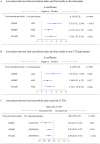Dietary fruit and vegetable intake, gut microbiota, and type 2 diabetes: results from two large human cohort studies
- PMID: 33267887
- PMCID: PMC7712977
- DOI: 10.1186/s12916-020-01842-0
Dietary fruit and vegetable intake, gut microbiota, and type 2 diabetes: results from two large human cohort studies
Abstract
Background: Little is known about the inter-relationship among fruit and vegetable intake, gut microbiota and metabolites, and type 2 diabetes (T2D) in human prospective cohort study. The aim of the present study was to investigate the prospective association of fruit and vegetable intake with human gut microbiota and to examine the relationship between fruit and vegetable-related gut microbiota and their related metabolites with type 2 diabetes (T2D) risk.
Methods: This study included 1879 middle-age elderly Chinese adults from Guangzhou Nutrition and Health Study (GNHS). Baseline dietary information was collected using a validated food frequency questionnaire (2008-2013). Fecal samples were collected at follow-up (2015-2019) and analyzed for 16S rRNA sequencing and targeted fecal metabolomics. Blood samples were collected and analyzed for glucose, insulin, and glycated hemoglobin. We used multivariable linear regression and logistic regression models to investigate the prospective associations of fruit and vegetable intake with gut microbiota and the association of the identified gut microbiota (fruit/vegetable-microbiota index) and their related fecal metabolites with T2D risk, respectively. Replications were performed in an independent cohort involving 6626 participants.
Results: In the GNHS, dietary fruit intake, but not vegetable, was prospectively associated with gut microbiota diversity and composition. The fruit-microbiota index (FMI, created from 31 identified microbial features) was positively associated with fruit intake (p < 0.001) and inversely associated with T2D risk (odds ratio (OR) 0.83, 95%CI 0.71-0.97). The FMI-fruit association (p = 0.003) and the FMI-T2D association (OR 0.90, 95%CI 0.84-0.97) were both successfully replicated in the independent cohort. The FMI-positive associated metabolite sebacic acid was inversely associated with T2D risk (OR 0.67, 95%CI 0.51-0.86). The FMI-negative associated metabolites cholic acid (OR 1.35, 95%CI 1.13-1.62), 3-dehydrocholic acid (OR 1.30, 95%CI 1.09-1.54), oleylcarnitine (OR 1.77, 95%CI 1.45-2.20), linoleylcarnitine (OR 1.66, 95%CI 1.37-2.05), palmitoylcarnitine (OR 1.62, 95%CI 1.33-2.02), and 2-hydroglutaric acid (OR 1.47, 95%CI 1.25-1.72) were positively associated with T2D risk.
Conclusions: Higher fruit intake-associated gut microbiota and metabolic alteration were associated with a lower risk of T2D, supporting the public dietary recommendation of adopting high fruit intake for the T2D prevention.
Keywords: Cohort; Fruit and vegetable; Gut microbiota; Metabolites; Type 2 diabetes.
Conflict of interest statement
All authors declare that they have no competing interests.
Figures



References
-
- Saeedi P, Petersohn I, Salpea P, Malanda B, Karuranga S, Unwin N, Colagiuri S, Guariguata L, Motala AA, Ogurtsova K et al. Global and regional diabetes prevalence estimates for 2019 and projections for 2030 and 2045: Results from the International Diabetes Federation Diabetes Atlas, 9th edition. Diabetes Res Clin Pact. 2019;157:107843. - PubMed
-
- Mamluk L, O'Doherty MG, Orfanos P, Saitakis G, Woodside JV, Liao LM, Sinha R, Boffetta P, Trichopoulou A, Kee F. Fruit and vegetable intake and risk of incident of type 2 diabetes: results from the consortium on health and ageing network of cohorts in Europe and the United States (CHANCES) Eur J Clin Nutr. 2017;71(1):83–91. doi: 10.1038/ejcn.2016.143. - DOI - PMC - PubMed
-
- Cooper AJ, Forouhi NG, Ye Z, Buijsse B, Arriola L, Balkau B, Barricarte A, Beulens JW, Boeing H, Buchner FL, et al. Fruit and vegetable intake and type 2 diabetes: EPIC-InterAct prospective study and meta-analysis. Eur J Clin Nutr. 2012;66(10):1082–1092. doi: 10.1038/ejcn.2012.85. - DOI - PMC - PubMed
Publication types
MeSH terms
Grants and funding
- 2019R52039/Zhejiang Ten-thousand Talents Program/International
- 82073529/National Natural Science Foundation of China/International
- 81903316/National Natural Science Foundation of China/International
- 81773416/National Natural Science Foundation of China/International
- LQ19C200005/Zhejiang Provincial Natural Science Foundation of China/International
LinkOut - more resources
Full Text Sources
Medical

